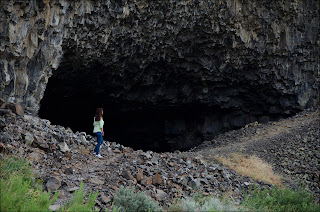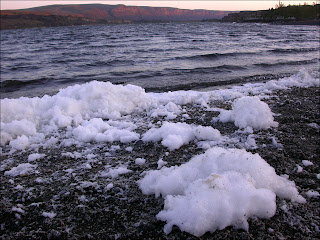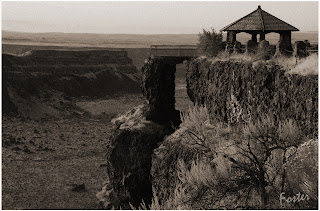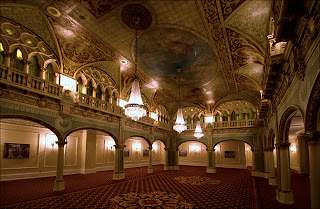You sure end up at plenty of amazing places when exploring Lake Bonneville, Lake Missoula and the Ice Age Floods! Along the way you also meet and read about some interesting people. Last weekend Teresa and I spent time in the Spokane area (No shortage of flood features to inspect between Pasco and Spokane ... We never seem to take the direct 395 ... I-90 route). One of the books I tossed into a bag while packing was an old 40 page booklet written by Washington State Park's employee Charles T. Giezentanner in the late 30s.
I always enjoy reading material by early visitors to the Ice Age Floods region. They had no satellite images or books/papers by guys like Atwater, Baker, Bjornstad, Bretz, O'Connor and Waitt to help unravel clues left by huge floods that swept through the area. I can't knock any of the conclusions reached by early Grand Coulee geology enthusiasts. I'm impressed with the energy they put into trying to figure out how the mysterious scabland of eastern Washington was created and also the love they had for the beautiful landscape.
Use caution with text below ... I think most of the pre-1950 facts and figures are posted in a green font. For current interpretation of Ice Age Flood evidence in the Grand Coulee ... I'd suggest Bruce Bjornstad's new book On the Trail of the Ice Age Floods the Northern Reaches.
While I'm at it ...I'll also include a few photos from the Spokane trip mentioned above (might get a little off topic). Spokane was one of the locations designated as a Gateway Community to the Ice Age Floods region in the NPS Study of Alternatives.
Black and white images below - from Washington State Parks, Central Washington University, Rufus Woods Collection, Washington State University and University of Washington.
Charles T. Giezentanner lectures at Dry Falls
"This is Dry Falls State Park, where waters flowed through for thousands of years and have remained dry for thousands of years more."
Giezentanner's explained the basic concept of Grand Coulee development: "The Grand Coulee formed during the glacial period by the forcing of the north rivers to a focal point near the Grand Coulee Dam and causing the water to flow down the valley until it cut the canyon."Giezentanner's water source was melting glacial ice. His estimated forty-two cubic miles of ice was melting daily when Dry Falls was formed.
"Chalice of the Gods" by C.T. Giezentanner
Printed by Yakima Bindery & Printing Company
First Edition 1937
Second Edition 1939
Third Edition 1940
Price Forty-Nine Cents
Printed by Yakima Bindery
40,000 Dry Falls visitors in 1934 ... 400,000 in 1938
"How quickly can a "damned pot-hole" be glorified when touched by the hand of God. ... Giezentanner"
Teresa and I enjoyed a stop at frosty Palouse Falls on our way to Spokane last weekend.
Davenport Hotel in Spokane. The hotel first opened in 1914. Sitting in the beautiful lobby sure gets you thinking about travelers in Washington State prior to 1950. They first arrived at the Davenport by rail and later by automobile. Many would have visited the Grand Coulee dam site and Dry Falls during their visit. The Davenport was a great place to read "Chalice of the Gods".
Charles and Georgia Giezentanner on viewing bridge at Dry Falls. Giezentanner refers to this location as "Observation Point". Apparently in Giezentanner's day, Dry Falls lake was also known as "The Vale of Tears".
The Giezentanners sure seemed to enjoy living in Washington State:
"The state itself, has become the premier scenic locality of the North American continent. It has more natural scenery than any two states in the Union."Interpretive display by Washington State Park Committee points out - falls at this location "Beat Niagara's Volume 40 to 1".
Sign also states: "Geologist Themselves can only Conjecture what Turned the Mighty Glacial Floods of the Upper Half of North America East and West from this Prehistoric Channel. The Mighty Mississippi - The Columbia - The Fraser - The Yukon - even the Romantic Mackenzie - HERE LIES THE SKELETON OF THE FATHER OF THEM ALL"Giezentanner uses a couple pages to describe the history of Washington State Parks. In 1940 Washington had set aside 57 parks after the initial park (Chuckanut Drive designation) was established in 1915.
The "Caretaker's Home"
Still stands at Dry Falls State Park
A 1936 Wenatchee Daily World story on the Giezentanner's mentions "The story of that romance is told in writing, placed in a bottle and buried in the Southeast pier of the caretaker's house by George Hall, the stone mason."
Georgia and her cat on steps of caretaker's house.
Poor cat! Living in the land of hungry coyotes and automobiles. I bet his speed was tested more than once... at least Charles tried to help. In the pamphlet Charles adds:
"P.S.-The Caretaker would appreciate it if you would keep your dogs in the cars until after leaving the Park Thanks a lot."
Wall construction at Observation Point
"From a geological viewpoint, Dry Falls - Mystery Falls of Washington - not only leads the group (National and State Parks within Washington State), but is now recognized as as the greatest natural wonder in the known world."
The "Old Caretaker" Charles T. Giezentanner - Merchant photo
"Formed during the glacial period by the ice forcing the north rivers to a focal point near the Grand Coulee Dam and causing the water to flow down the valley until it cut the canyon."Giezentanner believed it took 6,000 years to create the lower Grand Coulee between Soap Lake and Dry Falls and the cutting ended 100,000 years ago.
"The Grand Coulee is fifty-three miles long - two to five miles wide - and contains three world wonders.
- The Grand Coulee Dam - Is the greatest structural wonder in the world.
- Soap Lake - To the south - a panacca for many ailments, is the only place in the world where the dreaded Buerger's Disease can be arrested.
- Dry Falls - Today there is more geological interest centered on Dry Falls than any other natural wonder in the world."
Giezentanner describes Columbia River Basalt exposed at Dry Falls
(white box is State Park visitor center ... Vista House beyond)
"Every strata in the escarpment represents a different period of time - and you can count eight. It's the greatest basalt-lava formation in the world. It extends from Canada to Mexico, and the geologists have discovered over seventy of those strata - one on top of the other - here in the scab lands. And it contains iron sufficient to supply all the demands of the United States Government for an unlimited period of time."
Took many visits to this spot before I noticed basalt columns used in Vista House construction (lower left). Guess I was always distracted by Dry Falls (just out of view at right).
Busy day at the Vista House
"It is where scientists bow in reverence to a master mind And where the world's geologists disagree It's where the skeptic and infidel stand appalled And the atheist rides leagues to see."
I noticed the term "Umatilla Rock" (Name WSP uses today) was used in the book. In most pre-1950 references - Umatilla Rock is split into separate features ... "The Sphinx and Battleship Rock".
"The monolith at the head of the island is the Sphinx, It has stood guard over the remains for thousands of years before the Sphinx of Egypt was ever conceived. The lower rock is Battleship Rock."
"Congressmen See Wonders of Dry Falls of Columbia River"
I guess these guys usually wore coats during summer scabland exploration. Caption states: "A temperature of almost 100 degrees forced most of the party to leave coats behind".
Called "Lookout House" in this caption
Vista House looks better in the black and white photos
Frank McCann
I'd noticed Frank's name in material that described locals involved in selling the plan to build Grand Coulee Dam. I had no idea he had such an interest in the geology of the area. Giezentanner devotes a page to Mr. McCann and refers to him as "The Daddy of the Grand Coulee".
I'd noticed Frank's name in material that described locals involved in selling the plan to build Grand Coulee Dam. I had no idea he had such an interest in the geology of the area. Giezentanner devotes a page to Mr. McCann and refers to him as "The Daddy of the Grand Coulee".
"He had taken a preliminary course in geology and saw a vision. He claimed that some day Grand Coulee and Dry Falls would would come into their own. To that end he bent every effort to bring it about when other duties did not claim too much of his time. From that day until his death he sacrificed a part of his time and spent his own money in attracting to Grand Coulee some of the world's best geologists."
"Six hundred people representing seven counties attended his funeral - all of one mind that a monument to his memory should be be erected at some imposing point at Dry Falls. Whether this idea takes concrete form and is carried out or whether his dust moulders with that of other unsung and forgotten pioneers, who gave their all to make Washington State what it is remains to be seen."
According to Giezentanner ..."the Wenatchee World had this to say: Frank McCann did more than any other one man to publicize the remarkable geological features of Grand Coulee and Dry Falls. Of all the people he was the first to realize the importance of Dry Falls as a geological feature."
McCann involved with Bretz.
Marker honors Bretz at Dry Falls State Park
Surprised booklet has no mention of J Harlen Bretz. Bretz and Giezentanner must has had issues with each other???
Standing on Umatilla Rock
Giezentanner mentions Native Americans in the Grand Coulee and describes one of their legends. The story involves a witch turning an Indian into a coyote with a whale's stomach. The coyote stood on Umatilla rock and he caught fish for days and days until he was gorged.
Early inhabitants of the coulee left plenty of evidence. Huge Grand Coulee boulder shown is beautifully marked with petroglyphs.
Teresa visits on Lake Lenore caves in the lower Grand Coulee. Apparently Indians inhabiting the Grand Coulee used these flood-cut caves for storage and possibly shelter.
View from back of cave.Floor of the lower Grand Coulee in the distance.
Photo from Rufus Woods Collection (housed at Central Washington University) shows Dry Falls visitor on viewing platform.
"Not only the Columbia was flowing here, but there were enormous ice-caps melting, during the glacial age, and rivers from Okanogan and Canada - Including the Frazier and Mississippi - poured over with a flood-tide fifty feet high where it broke over the brink. ... Giezentanner"
Good sounds below the falls.
Photo shows Tom Tabbert flying below the rim at Dry Falls - shooting aerial footage for Nick Zentner's State Park visitor center program. I remember being amazed at how loud Tabbert's trike was in the lower Grand Coulee. Giezentanner also noticed Dry Falls acoustics.
"The bowl below the Falls, in which the islands of the Sphinx and Battleship are located, is shaped very much like the human ear. When the lecturer is speaking, and the atmospheric conditions are harmonizing, every word he says can be distinctly heard for an unbelievable distance. If seats could be arranged to seat five million people in the bowl all could hear the lecturer at the same time."
Soap Lake (lower end of the Grand Coulee)
Soap Lake was a big deal when Giezentanner was at Dry Falls. In the mid 1930s it was belived the lake could help prevent or help those with Buerger's disease and many other ailments. Giezentanner describes talking with a woman on her way to Soap Lake ... hoping the water would grow skin on her artificial limb.
Soap Lake beauty contest
"It is known as one of the six wonders of the nation, but, if properly classified, would rank all the pre-historic wonders of the ages. It would stand out alone and stand supreme as the Wonder of Wonders and the Mystery of Mysteries".
Teresa and Dry Falls Interpretive Panel 2012
Looks better without the giant white box!
Dry Falls Vista House 2011 (Foster)
Teresa in historic Davenport Hotel lobby.
During the war years, the skylight was blacked out as a civil defense measure.
Main Lobby at the Davenport Hotel. Many interesting displays related to the hotel's history have been placed on mezzanine.
Teresa in the Hall of Doges
The story of the Hall of Doges in incredible. During restoration of the hotel, Mr. and Mrs. Worthy had the Hall of Doges lifted with cranes for safe storage across the street before returning the cherished structure to the Davenport.
The Marie Antoinette Ballroom
Even the smaller fixtures in the Davenport are interesting.
(I like the mouth anchor point)
The three largest Chandeliers in the Marie Antoinette Ballroom were $10,000 each in 1914.
Grand Pennington Ballroom
- A few phone photos -
Top: Teresa above Spokane River at site of 1974 World's Fair (see text block below). Center: Interesting stuffed critters at Cabela's (Post Falls, Idaho) on the way to Coeur d'Alene. Bottom photo taken in Spokane's Manito Park conservatory.
Text below from National Park Service "Ice Age Floods Study of Alternatives".
"While there has been more than a casual interest in the Ice Age Floods story on the local and state levels, very little appreciation for the national significance of the Flood events has been noted, except from within the scientific and professional geologic community. The Ice Age Floods story was publicized during the 1974 World’s Fair in Spokane, Washington."
Great trip! Always fun to stay at the Davenport!
Thanks for writing it down Charles!
















































